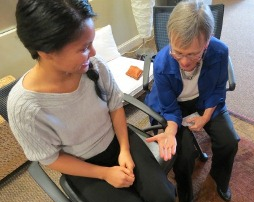Establishing the Evidence Base for Acupuncture
The long term goals of our research on acupuncture are to inform military researchers, clinicians and policy makers about the evidence base for acupuncture use, identify research gaps, and to work with military leaders to integrate acupuncture into care paradigms in a variety of military environments.
Projects
- Acupuncture & TBI Headache: Randomized control trial of acupuncture for the treatment of headaches associated with Traumatic Brain Injury at WRNMMC and Fort Belvoir Community Hospital.
- Acupuncture & Trauma Spectrum Response: Systematic review examining the effectiveness of acupuncture for components of Trauma Spectrum Response.
- Battlefield Acupuncture: After two promising pilot studies, the United States Air Force and Samueli Institute developed the first DoD training program to teach military primary care physicians this simple procedure.
- Acupuncture & Chronic Pain: An epidemiological data analysis study to evaluate the impact of acupuncture utilization on narcotic load and additional utilization of conventional interventions within a chronic pain population.
- BioModulatorTM for Chronic Pain: A randomized control trial comparing the Tennant BioModulatorTM to Transcutaneous Electrical Nerve Stimulation (TENS) and Traditional Chinese Acupuncture for the symptomatic treatment of chronic pain among injured Service members.
Why Acupuncture?
 The stresses and injuries sustained by U.S. Service members in the current conflicts and the chronic medical conditions facing veterans present many challenges to current, conventional medical approaches.
The stresses and injuries sustained by U.S. Service members in the current conflicts and the chronic medical conditions facing veterans present many challenges to current, conventional medical approaches.
New and innovative ways to address the full spectrum of the disorders resulting from these stresses and injuries are being identified and evaluated. Acupuncture is a whole-systems treatment approach that is effective for pain and other trauma-related conditions.
|
This work is supported by the US Army Medical Research and Materiel Command under Award Numbers:
W81XWH-08-2-0212; W81XWH-11-2-0173; W81XWH-08-1-0408; W81XWH-11-1-0759; W81XWH-10-1-0820; W81XWH-07-2-0076; W81XWH-06-1-0279; W81XWH-06-2-0009; W81XWH-10-1-1011; W81XWH-10-2-0184; W81XWH-08-1-0615; W81XWH-10-1-0938; W81XWH-11-1-0538
The views, opinions and/or findings contained in this report are those of the author(s) and should not be construed as an official Department of the Army position, policy or decision unless so designated by other documentation.
In the conduct of research where humans are the subjects, the investigator(s) adhered to the policies regarding the protection of human subjects as prescribed by Code of Federal Regulations (CFR) Title 45, Volume 1, Part 46; Title 32, Chapter 1, Part 219; and Title 21, Chapter 1, Part 50 (Protection of Human Subjects).
|